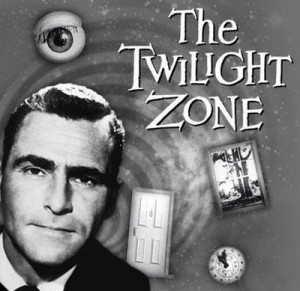Bibliography
Bibliography
Works Cited
Annotated Bibliography
Baughman, L. James. Same Time, Same Station: Creating American Television, 1948-1961. Baltimore: Johns Hopkins University Press, 2007. Print.
This book follows a history of early television and the tools and techniques utilized in its development. It explores many of those topics from the scientific to the policy making and the artistic experimentation of some of its pioneers. I used this book as a starting point in my research, citing the habit principle and the audience’s awareness or lack thereof of embedded messages.
Booker, M. Keith. “Pop Culture Universe.” 2002. The Twilight Zone and American Society in the Long 1950s: Between the Modern and the Postmodern 11 November 2009. Web. .
This is an excerpt from a book I found in an online Journal. The excerpt explores the transition of American society from modern to postmodern through an examination of 50’s television. I gathered from this excerpt the information on Mennipean satire and critical examinations of several episodes.
Carroll, Noel. “TV and Film: A Philosophical Perspective. Journal of Aesthetic Education 35.1
(2001): 15-29. Print.
This book explores the philosophies embedded in The Twilight Zone. I used this book to highlight some of my own personal takes on the aesthetics and how it influenced me.
Carroll, Noel and Lester H. Hunt. Philosophy in The Twilight Zone. Oxford: Wiley-Blackwell, 2009. Print.
This is an essay on TV and Film exploring some of the philosophical elements of viewing and engaging the material. I drew from the concept of glancing versus gazing techniques utilized by viewers.
Cochran, David. American Noir: Underground Writers and Filmmakers of the Postwar Era. Washington: Smithsonian Institution Press, 2000. Print.
This book explores some of the fringe elements of American cinema and television in the context of Noir. I used it as a historical reference to the cold war era that Serling was writing during.
Engel, Joel. Rod Serling: The Dreams and Nightmares of Life in the Twilight Zone. Chicago: Contemporary Books, 1989. Print.
This is a biography of Rod Serling’s life. I used it to explore some of the personal matters of Serling’s life and highlight his successes and stardom.
Farber, Stephen and Marc Green. Outrageous Conduct: Art, Ego, and the Twilight Zone Case. New York: Arbor House, 1988. Print.
This book was a bit of an expose’ and Hollywood sensationalism. I used a quote from this book to highlight Serling’s forsight.
Fluck, Winfried. Rev. of “American Noir: Underground Writers and Filmmakers of the Postwar Era,” by David Cochran. The Journal of American History (2001): 1147-1148. Print.
This was a review of the book American Noir. From it I gathered a different example and a condensed message which I used to back up a concept of Serling’s vision.
Hoppenstand, Gary. “Television as Metaphor.” The Journal of Popular Culture (2004): 561-563. Print.
This was a piece of light writing but I used it to identify some themes and topics approached by Rod Serling.
Kaplan, Oren. “The Effect of The Hypnotic-Suggestive Communication Level of Advertisments on Their Effectiveness.” Contemporary Hypnosis 24.2 (2007): 53-63. Print.
This was an in depth look at marketing and its subliminal affects. It detailed a study in Israel done on subliminal messages. I used this to highlight the technique used by Serling and how it did indeed fall within many of the guidelines for hypnotic suggestion.
Kraszewski, Jon. “Authorship and Adaptation: The Public Personas of Television Anthology Writers.” Quarterly Review of Film and Video 25 (2008): 271-285. Print.
This article explores the variables and circumstances of the anthology writers in the 1950’s. I used this to highlight how Rod Serling was able to ascend to stardom as an author.
Mandell, Paul. “Walking the Distance from the Twilight Zone.” American Cinematographer 69.6 (1988): 36-43
This is article is a praise and description of the episode ‘Walking Distance’. I used this to bolster my own descriptions of The Twilight Zone.
Metress, Christopher. “Submitte for Their Approval: Rod Serling and the Lynching of Emmett Till.” Miss Q (2008): 143-171. Print.
This essay examines the burden and hurdles of censorship facing Rod Serling. It focuses on his battle of the script he based off of the lynching of Emmitt Till. I used this to lay the foundation for the how and why Rod Serling designed a strategy for circumnavigating censors.
Nelson, Michelle R. “The Hidden Persuaders: Then and Now.” Journal of Advertising (2008): 114-126. Print.
This is an essay the revisits the book The Hidden Persuaders. It argues that what at the time what might have been disregarded as flawed science in regard to subliminal messages has now through time become legitimized by data. I used this to define supraliminal messages and add credence to my argument of suggestion.
Pratkanis, R. Anthony and Elliot Aronson. Age of Propaganda: The Everyday Use and Abuse of Persuasion. New York: W.H. Freeman and Company, 1992. Print.
This book explores the history of propaganda as well as its use in modern culture. I used this book to highlight the receptivity of the American public to media.
Taylor, Eldon. “Subliminal Information Theory Revisited: Casting Light on a Controversy.” Annals (2007): 29-33. Print.
This is an article exploring subliminal messages in television marketing. I used this article to describe the new forms of subliminal overload.

